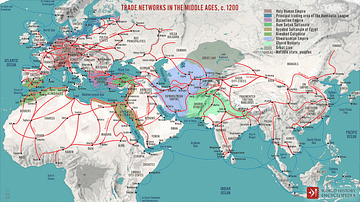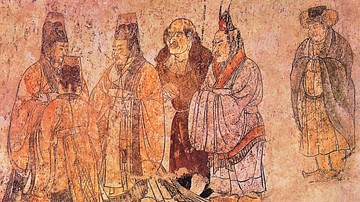Review

| Rating: | |
|---|---|
| Title: | The King’s Road: Diplomacy and the Remaking of the Silk Road |
| Author: | Xin Wen |
| Audience: | University |
| Difficulty: | Hard |
| Publisher: | Princeton University Press |
| Published: | 2023 |
| Pages: | 400 |
Based on the manuscripts found in Dunhuang, China, this book is an account of the diplomatic missions that took place in eastern Eurasia between 800 CE and 1100 CE. Xin Wen's work is a specialist book that would be difficult to read for someone unfamiliar with the topic, but it provides an excellent analysis of a much-neglected topic.
Since the appearance of "world history" as an academic subgenre in the 1990s, the Silk Road has received considerable attention. The causes behind this focus of scholarly attention are not difficult to understand. For those seeking an alternate interpretation of history from the idea of the "Rise of the West," the Silk Road offers endless areas to explore, both literally and figuratively. The concept of the "Silk Road" itself is an abstraction. There was never just one Silk Road. Rather, there were many smaller roads that, when viewed together, formed a network that facilitated the movement of not just goods but also ideas and techniques across Eurasia. The validity of the term "Silk Road" has been called into question, but Xin Wen's The King’s Road: Diplomacy and the Remaking of the Silk Road reaffirms the term's usefulness as a way of understanding an important theme of human history. This is a study of diplomatic relations in eastern Eurasia between 800 CE and 1100 CE based on the trove of documents discovered in Dunhuang, an oasis town in Gansu Providence, China, in the early 20th century.
Rather than focusing on the political aspect of diplomatic relations, Xin Wen, Assistant Professor of East Asian Studies and History at Princeton University, concentrates on the practical aspects of relations in what he calls a "bottom-up view" of diplomacy (8). The book is an excellent balance of detailed analysis of primary sources while also showing the significance of those documents in a broad historical context. As Wen points out, the city of Dunhuang was at the intersection of three important roads. One led to East Asia through the Hexi Corridor, one went to North Asia through the valleys of the Tianshan Mountains, and one extended into Central Asia through the oases and deserts north of the Tibetan Plateau. This book shows Dunhuang's strategic importance since it lay at the heart of the conflicts and trade routes among various states in eastern Eurasia.
This book is divided into three parts, and each part has its own guiding question. In Part One, the author asks: who became diplomatic travelers? The book then spends its first three chapters on this question. Chapter One introduces the Dunhuang manuscript collection. Chapter Two gives an account of the extremely diverse people who made up diplomatic missions. Chapter Three focuses on the commodities that the diplomats carried with them, such as food, clothes, texts, animals, and luxury items. Part Two poses the question: how did they travel? This question is answered in the next four chapters. Chapter Four looks at the physical conditions of the road, and Chapter Five deals with the social customs of travelers. Chapter Six explains the important role of gift-giving in diplomatic exchanges, and Chapter Seven studies the use of language. In Part Three, the author explores the inquiry regarding the types of international connections that the travelers created. The next three chapters of the book, which explore this question, look at the economic, political, and cultural consequences of the network of diplomatic travelers.
The book's overall argument is that, despite the decline of the Tang Dynasty, the Silk Road continued to function - although in a more fragmented political environment - as a mechanism for the exchange of people, goods, and ideas in eastern Eurasia. This book is a remarkably in-depth analysis of an important topic that has previously received little attention. As one might expect from such an academic book, it is written in a very formal and scholarly tone with few maps and illustrations. It would probably be a difficult book for a reader without some degree of familiarity with the topic. To the field of Asian Studies, this book is a highly valuable and insightful new contribution.
About the Reviewer
Cite This Work
APA Style
Squires, G. (2023, February 17). The King’s Road: Diplomacy and the Remaking of the Silk Road. World History Encyclopedia. Retrieved from https://www.worldhistory.org/review/305/the-kings-road-diplomacy-and-the-remaking-of-the-s/
Chicago Style
Squires, Graham. "The King’s Road: Diplomacy and the Remaking of the Silk Road." World History Encyclopedia. Last modified February 17, 2023. https://www.worldhistory.org/review/305/the-kings-road-diplomacy-and-the-remaking-of-the-s/.
MLA Style
Squires, Graham. "The King’s Road: Diplomacy and the Remaking of the Silk Road." World History Encyclopedia. World History Encyclopedia, 17 Feb 2023, https://www.worldhistory.org/review/305/the-kings-road-diplomacy-and-the-remaking-of-the-s/. Web. 24 Apr 2025.




